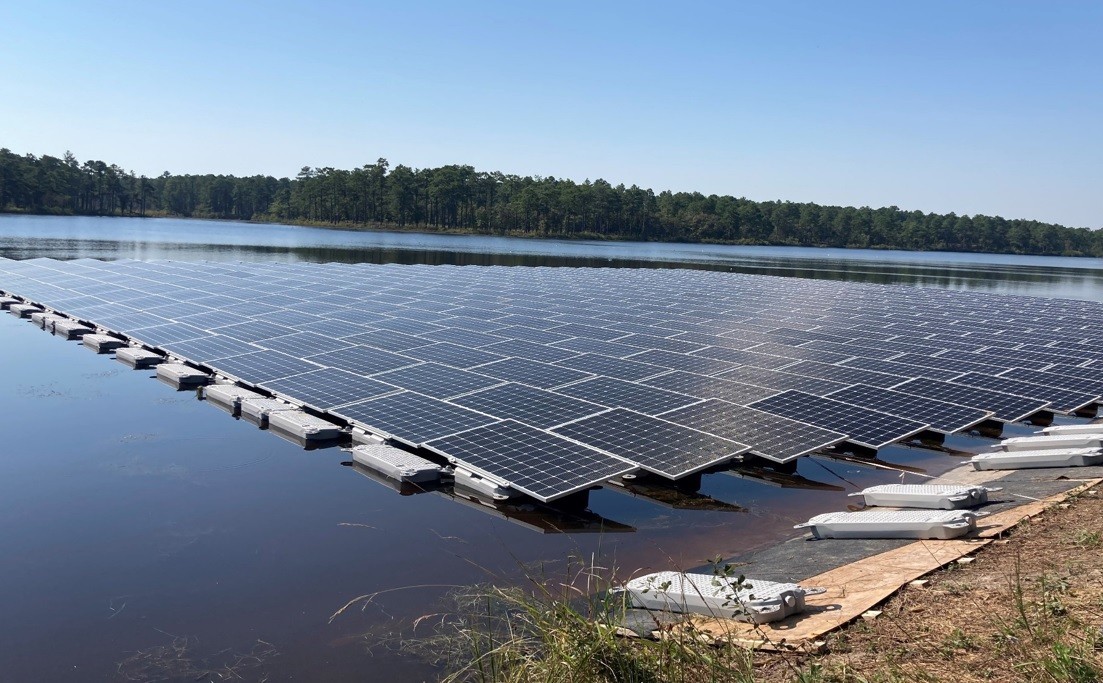In a collaboration with Fort Bragg, Duke Energy and Ameresco, a 1.1 MW floating solar installation was built on the Big Muddy Lake located at Camp Mackall. The project is part of a $36 million contract that focused on energy resilience and security at Fort Bragg.
Fort Bragg will own and operate the solar system, which is paired with a 2 MW battery energy storage system. The system will supply power to the fort from the local grid and provide power during electric service outages.
“With this system, the largest floating solar array in the Southeast, we will be able to provide energy resiliency to Fort Bragg operations through sustainable resources,” said Col. Scott Pence, garrison commander for Fort Bragg. “With this partnership, Fort Bragg not only has renewable electricity, but energy security that will be critical with continuing the installation’s mission during a power outage.”
The US Army recently announced a commitment to be carbon free by 2030, and a plan to build renewable energy projects on its bases, as well as purchasing clean electricity. By 2035 the Army aims to install a microgrid on every installation, with the goal being able to “self-sustain its critical missions” on all its installations by 2040.
“This project fulfills the commitment made in our Army Climate Strategy to increase resilience while delivering clean energy and reducing greenhouse gas emissions,” said the Honorable Rachel Jacobson, assistant secretary of the Army for installations, energy and environment. “When we collaborate with local utilities and industry to promote energy resilience while powering the local grid, it is a winning solution across the board.”
With this first floating solar installation operational, Fort Bragg may put solar on its other bodies of water.
“Floating solar allowed us to provide energy security and resiliency without reducing training lands,” Audrey Oxendine, Fort Bragg’s energy and utilities branch chief said. It was estimated that seven acres of cleared land would be needed for 1 MW of traditional ground mounted solar, but the 1 MW of floating solar only required two acres of water surface area, she explained.
Fort Bragg has the largest population of any US military installation, with approximately 49,000 military personnel, 11,000 civilian employees and 23,000 family members. It covers over 251 square miles in four counties in Duke Energy’s territory in North Carolina. The state was ranked fourth in the United States for installed solar, obtaining just over 8% of its electricity from solar energy. Duke Energy owns and operates more than 40 solar facilities in North Carolina, one of which is a 13-MW facility at the Marine Corps Base Camp Lejeune in Onslow County.
This content is protected by copyright and may not be reused. If you want to cooperate with us and would like to reuse some of our content, please contact: editors@pv-magazine.com.









By submitting this form you agree to pv magazine using your data for the purposes of publishing your comment.
Your personal data will only be disclosed or otherwise transmitted to third parties for the purposes of spam filtering or if this is necessary for technical maintenance of the website. Any other transfer to third parties will not take place unless this is justified on the basis of applicable data protection regulations or if pv magazine is legally obliged to do so.
You may revoke this consent at any time with effect for the future, in which case your personal data will be deleted immediately. Otherwise, your data will be deleted if pv magazine has processed your request or the purpose of data storage is fulfilled.
Further information on data privacy can be found in our Data Protection Policy.